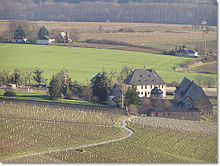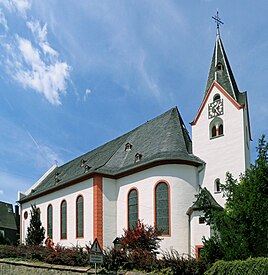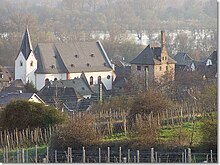Hattenheim
|
Hattenheim
City of Eltville on the Rhine
|
|
|---|---|
| Coordinates: 50 ° 0 ′ 50 ″ N , 8 ° 3 ′ 39 ″ E | |
| Height : | 95 m above sea level NHN |
| Area : | 12 km² |
| Residents : | 2181 (Dec. 31, 2015) |
| Population density : | 182 inhabitants / km² |
| Incorporation : | July 1, 1972 |
| Postal code : | 65347 |
| Area code : | 06723 |
|
Parish Church of St. Vincentius
|
|
Hattenheim has been a district and local district of the rose town of Eltville am Rhein in the Rheingau-Taunus district in southern Hesse since 1972 .
history



Hattenheim was very likely settled as early as the Neolithic . This is evident from finds in the area of today's primary school and the surrounding area. The assumption goes back to a foundation of the Rhine Franconia, probably from the 8th century. A certain Hadur or Hadir settled here. The name of the place in the Rheingau used to be formed by the personal name + heim. The Hadirsheim can be derived from this.
Hattenheim is first mentioned in writing around 954. At that time, Hattenheim became a church branch of Eltville. The place got the right to occupy its chapel with a priest who was allowed to baptize and baptize. Around 1118 the Hattenheimer Burg was built or extended to this structure. It served the "nobles of Hattenheim" and later passed to Baron Langwerth von Simmern and is still owned by the family today. The Greiffenclauer Hof settled next to the castle. In 1174 the community of Hattenheim donated a spring to the neighboring Eberbach monastery . The monastery inventory of goods from 1211 shows that most of the vineyards belonged to the monastery at that time. In 1239, Hattenheim sold a path through Steinberg and the Mehrholz forest to the Eberbach monastery. The Margaret Chapel and the oldest half-timbered house were built around 1320/1321.
The important Hattenheim viticulture is particularly confirmed by the well-known Schröderbruderschaftsbuch from 1442. In 1488 Hattenheim got its own court seal. Around 1740 the Hattenheim baroque church St. Vincentius was built on the place of the Margaret Chapel. It was dedicated to the martyr Vincent of Valencia . The early Gothic tower dates back to the 13th century. The Auxiliary Bishop of Mainz Johann Valentin Heimes was born in Hattenheim in 1741 as the third child of the winemaker Christian Heimes.
Since the founding of Hattenheim, the large estates of the families Baron Langwerth von Simmern , Count von Schönborn-Wiesentheid , Prince Friedrich of Prussia, Count Matuschka- Greiffenclau , as well as the state domain and the city of Eltville dominated. Hattenheim had more than 80 independent wine-growing businesses.
Auxiliary Bishop Valentin Heimes dies in 1806 at the age of 65. In 1814 Johann Wolfgang von Goethe took a cure in Wiesbaden. During a trip through the Rheingau on August 16, 1814, he also visited the Rochus Festival in Hattenheim.
Hattenheim belonged with the entire Rheingau to the Kurmainzian territory. After the dissolution of the Electoral state the place in 1803 went to Nassau-Usingen and belonged to the time of the Duchy of Nassau for Office Eltville . After the annexation of the duchy by Prussia , the place was assigned to the Rheingau district in the Wiesbaden administrative region in 1867 .
As part of the regional reform in Hesse , Hattenheim was incorporated into the city of Eltville on July 1, 1972 on a voluntary basis . Local districts with local advisory councils and local councilors were formed for both the core city and the city districts .
Religions
The Protestant Christians of Hattenheim belong to the Evangelical Church Community of Oestrich-Winkel, which was founded in 1891 and whose church is located in the Oestrich-Winkler district of Mittelheim . The Catholic parish of St. Vincentius is part of the Eltville pastoral area .
Twin town
Culture and sights
Buildings
- Hattenheim Castle
- Parish Church of St. Vincentius
- Rectory
- town hall
- Eberbach Monastery
- Hotel and restaurant " Kronenschlösschen "
- Reichartshausen Castle
- House of the butcher's shop Ress
- Georg Müller Foundation winery with art cellar in Wilhelmj-Haus
- Balthasar Ress winery
- Wachendorff house
- Hotel and wine house "Zum Krug"
- Marketplace
- Fountain of Hattenheim
- Steinberg (today owned by the Hessian State Wine Estate )
- Eichberg
- Hattenheim station
- Oak at the campsite with a chest height of 7.08 m (2014).
Regular events
- The castle festival
- The ostrich economy in the castle
- Pure nature (always on October 3rd)
Hattenheim vineyards
Hattenheim is particularly preferred among the wine villages of the Rheingau due to the quality of the soil. With 268 hectares of vineyards, viticulture in Hattenheim takes up most of the agriculturally usable area. The vineyards of the Hattenheim district are summarized in the large Deutelsberg area.
The most famous location is the Steinberg , which was laid out in the Middle Ages by the Cistercian monks of the neighboring Eberbach Monastery at the edge of the forest on a steep southwest slope and was surrounded by a high slate-covered quarry stone wall. The wall served to protect the vineyard, it also favored the microclimate and was named because of the amount of stones used there. The Steinberg was managed via the adjacent Neuhof , a farm yard of the monastery. The Steinberg is the sole property of the Hessian State Winery Kloster Eberbach and has been home to the new Steinbergkeller , the central winery of the State Winery , since 2008 .
Other well-known locations are the well locations Nussbrunnen and Wisselbrunnen , which are often mentioned in the same breath as the neighboring Erbacher Marcobrunn . The Mannberg also shares a border with it and is, so to speak, its extension to the west along the old federal road to the locality of Hattenheim. The locations are completed by Pfaffenberg , Hinterhaus, Hassel, Engelmannsberg, Schützenhaus and Heiligenberg . Last but not least, think of the Rheingarten , which also extends to the Mariannenaue island .
Personalities
- Auxiliary Bishop Gottfried Langwerth von Simmern (* 1669 in Hattenheim (Castle of Hattenheim), † 1741), Auxiliary Bishop of Regensburg
- Auxiliary Bishop Johann Valentin Heimes (* 1741 in Hattenheim; † 1806), Auxiliary Bishop of Mainz and Auxiliary Bishop of Worms
- Heinrich Bone (born September 25, 1813 in Drolshagen district of Olpe, † June 10, 1893 in Hattenheim) was a German educator and writer.
- Heinrich Köppler (born November 26, 1925 in Hattenheim; † April 20, 1980 in Düsseldorf ) was a member of the German Bundestag from 1965 to August 8, 1970, and of the North Rhine-Westphalian state parliament from 1970 to 1980.
Web links
- Hattenheim. In: website. City of Eltville
- Hattenheim - History of a Wine Village (PDF; 9.3 MB) Chronicle by Valentin Statzner
- Picture by Hattenheim from JF Dielmann, A. Fay, J. Becker (draftsman): FC Vogel's panorama of the Rhine, pictures of the right and left banks of the Rhine. Lithographic institute FC Vogel, Frankfurt 1833
- Hattenheim, Rheingau-Taunus-Kreis. Historical local dictionary for Hessen. In: Landesgeschichtliches Informationssystem Hessen (LAGIS).
- Literature about Hattenheim in the Hessian Bibliography
Individual evidence
- ^ Hattenheim, Rheingau-Taunus district. Historical local dictionary for Hessen. (As of October 16, 2018). In: Landesgeschichtliches Informationssystem Hessen (LAGIS).
- ↑ 3429 population figures according to Eltville's registration office , accessed in June 2019
- ^ Municipal reform in Hesse: mergers and integrations of municipalities from June 21, 1972 . In: The Hessian Minister of the Interior (ed.): State Gazette for the State of Hesse. 1972 No. 28 , p. 1197 , item 851; 2. Para. 4. ( Online at the information system of the Hessian State Parliament [PDF; 4.4 MB ]).
- ↑ main statute. (PDF; 70 kB) §; 6. In: Website. City of Eltville, accessed February 2019 .
- ^ Entry in the directory of monumental oaks . Retrieved January 10, 2017
- ↑ Steinbergkeller on the Internet





